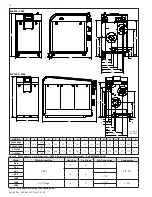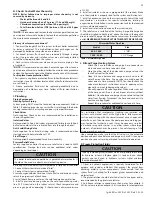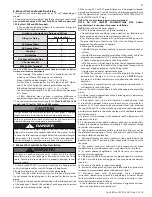
lp-666 Rev. 003 Rel. 001 Date 2.25.20
11
Different vent terminals can be used to simplify and eliminate
multiple penetrations in the building structure (see Optional
Equipment in Venting Section). The exhaust vent and intake piping
lengths, routing, and termination methods must all comply with the
methods and limits given in the Venting Section, this manual.
When installing a combustion air intake from outdoors, care must
be taken to utilize uncontaminated combustion air.
To prevent
combustion air contamination, see Table 1.
2. Power Venting, Indoor Combustion Air in Confined or
Unconfined Space
This boiler requires fresh, uncontaminated air for safe operation and
must be installed in a mechanical room where there is adequate
combustion and ventilating air.
NOTE: To prevent combustion air
contamination, see Table 1.
Combustion air from the indoor space can be used if the space has
adequate area or when air is provided through a duct or louver to
supply sufficient combustion air based on the boiler input. Never
obstruct the supply of combustion air to the boiler. If the boiler
Figure 7 - Direct Vent Examples
is installed in areas where indoor air is contaminated (see Table 1)
it is imperative that the boiler be installed as direct vent so that all
combustion air is taken directly from the outdoors into the boiler
intake connection.
Unconfined space
is space with volume greater than 50 cubic feet
per 1,000 BTU/hr (4.8 cubic meters per kW) of the total input rating of
all fuel-burning appliances installed in that space. Rooms connected
directly to this space through openings not furnished with doors are
considered part of the space. See Venting Section for details.
Confined space
is space with volume less than 50 cubic feet per
1,000 BTU/hr (4.8 cubic meters per kW) of the total input rating of
all fuel-burning appliances installed in that space. Rooms connected
directly to this space through openings not furnished with doors are
considered part of the space.
When drawing combustion air from inside a conventionally constructed
building to a confined space, such space should be provided with two
permanent openings: one located 6” (15 cm) below the space ceiling,
the other 6” (15cm) above the space floor. Each opening should have a
free area of one square inch per 1,000 BTU/hr (22cm
2
/kW) of the total
input of all appliances in the space, but not less than 100 square inches
(645cm
2
).
If the confined space is within a building of tight construction, air for
combustion must be obtained from the outdoors as outlined in the
Venting section of this manual.
CAUTION
When drawing combustion air from the outside into the mechanical
room, care must be taken to provide adequate freeze protection.
WARNING
!
Failure to provide an adequate supply of fresh combustion air can
cause poisonous flue gases to enter the living space, resulting
in severe personal injury or death. To prevent combustion air
contamination, see Table 1.
In the Commonwealth of Massachusetts and As Required by State
and Local Codes:
Installation of Carbon Monoxide Detectors: At the time of installation
or replacement of the vented gas fueled appliance, the installing
plumber or gas fitter shall observe that a hard wired carbon monoxide
detector with an alarm and battery back-up is installed on the floor
level where the gas appliance is installed, unless the appliance is
located in a detached, uninhabitable structure separate from the
dwelling, building, or structure used in whole or in part for residential
purposes.
In addition, the installing plumber or gas fitter shall observe that a hard
wired carbon monoxide detector with an alarm and battery back-up is
installed on each additional level of the dwelling, building, or structure
served by the vented gas appliance. It shall be the responsibility of the
G. Carbon Monoxide Detectors
property owner to secure the service of qualified licensed professionals
for the installation of hard wired carbon monoxide detectors.
a. In the event that the vented gas fueled appliance is installed in a
crawl space or attic, the hard wired carbon monoxide detector with
alarm and battery back-up shall be installed on the next adjacent
floor level.
b. In the event that these requirements cannot be met at the time of
completion of installation, the owner shall have a period of thirty (30)
days to comply with the above requirements; provided, however,
that during said thirty (30) day period, a battery operated carbon
monoxide detector with an alarm shall be installed.
WARNING
!
Do not attempt to vent this appliance by any means other than those
described in this manual. Doing so will void the warranty and may
result in severe personal injury or death.












































